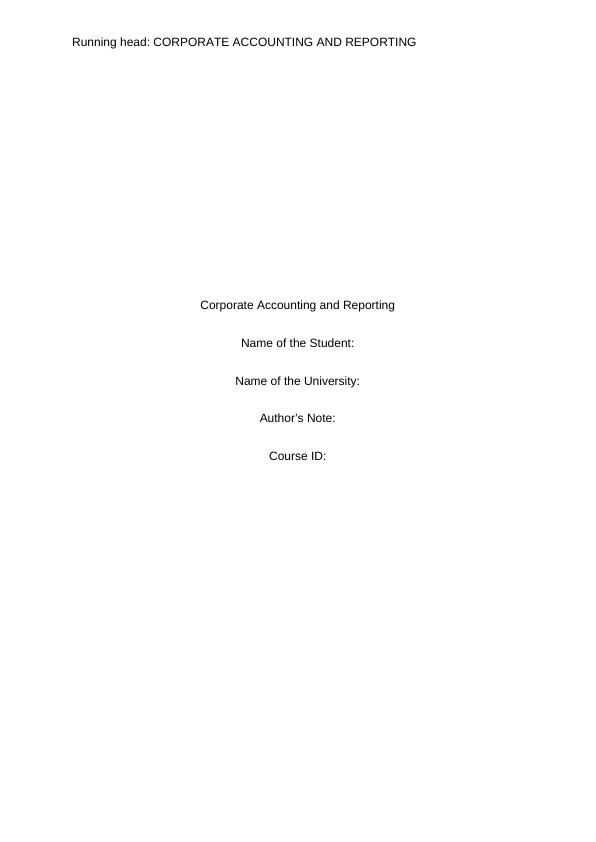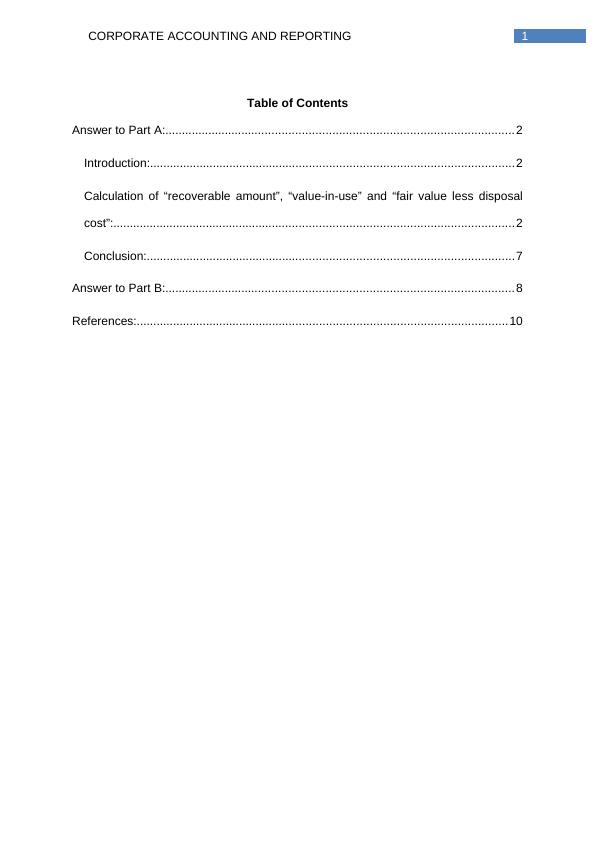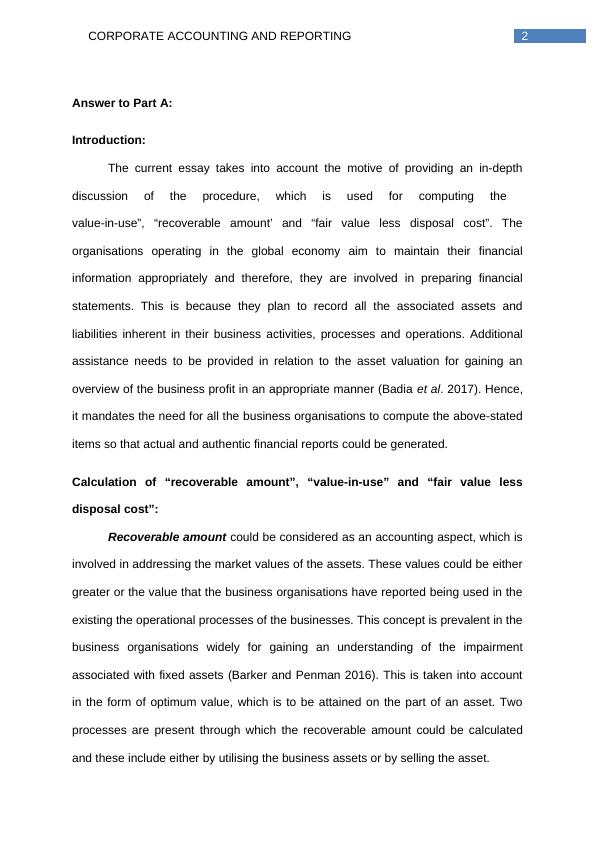Corporate Accounting and Reporting: Calculation of Recoverable Amount, Value-in-use and Fair Value Less Disposal Cost
Added on 2023-06-11
12 Pages2741 Words351 Views
Running head: CORPORATE ACCOUNTING AND REPORTING
Corporate Accounting and Reporting
Name of the Student:
Name of the University:
Author’s Note:
Course ID:
Corporate Accounting and Reporting
Name of the Student:
Name of the University:
Author’s Note:
Course ID:

1CORPORATE ACCOUNTING AND REPORTING
Table of Contents
Answer to Part A:........................................................................................................ 2
Introduction:.............................................................................................................2
Calculation of “recoverable amount”, “value-in-use” and “fair value less disposal
cost”:........................................................................................................................2
Conclusion:..............................................................................................................7
Answer to Part B:........................................................................................................ 8
References:...............................................................................................................10
Table of Contents
Answer to Part A:........................................................................................................ 2
Introduction:.............................................................................................................2
Calculation of “recoverable amount”, “value-in-use” and “fair value less disposal
cost”:........................................................................................................................2
Conclusion:..............................................................................................................7
Answer to Part B:........................................................................................................ 8
References:...............................................................................................................10

2CORPORATE ACCOUNTING AND REPORTING
Answer to Part A:
Introduction:
The current essay takes into account the motive of providing an in-depth
discussion of the procedure, which is used for computing the
value-in-use”, “recoverable amount’ and “fair value less disposal cost”. The
organisations operating in the global economy aim to maintain their financial
information appropriately and therefore, they are involved in preparing financial
statements. This is because they plan to record all the associated assets and
liabilities inherent in their business activities, processes and operations. Additional
assistance needs to be provided in relation to the asset valuation for gaining an
overview of the business profit in an appropriate manner (Badia et al. 2017). Hence,
it mandates the need for all the business organisations to compute the above-stated
items so that actual and authentic financial reports could be generated.
Calculation of “recoverable amount”, “value-in-use” and “fair value less
disposal cost”:
Recoverable amount could be considered as an accounting aspect, which is
involved in addressing the market values of the assets. These values could be either
greater or the value that the business organisations have reported being used in the
existing the operational processes of the businesses. This concept is prevalent in the
business organisations widely for gaining an understanding of the impairment
associated with fixed assets (Barker and Penman 2016). This is taken into account
in the form of optimum value, which is to be attained on the part of an asset. Two
processes are present through which the recoverable amount could be calculated
and these include either by utilising the business assets or by selling the asset.
Answer to Part A:
Introduction:
The current essay takes into account the motive of providing an in-depth
discussion of the procedure, which is used for computing the
value-in-use”, “recoverable amount’ and “fair value less disposal cost”. The
organisations operating in the global economy aim to maintain their financial
information appropriately and therefore, they are involved in preparing financial
statements. This is because they plan to record all the associated assets and
liabilities inherent in their business activities, processes and operations. Additional
assistance needs to be provided in relation to the asset valuation for gaining an
overview of the business profit in an appropriate manner (Badia et al. 2017). Hence,
it mandates the need for all the business organisations to compute the above-stated
items so that actual and authentic financial reports could be generated.
Calculation of “recoverable amount”, “value-in-use” and “fair value less
disposal cost”:
Recoverable amount could be considered as an accounting aspect, which is
involved in addressing the market values of the assets. These values could be either
greater or the value that the business organisations have reported being used in the
existing the operational processes of the businesses. This concept is prevalent in the
business organisations widely for gaining an understanding of the impairment
associated with fixed assets (Barker and Penman 2016). This is taken into account
in the form of optimum value, which is to be attained on the part of an asset. Two
processes are present through which the recoverable amount could be calculated
and these include either by utilising the business assets or by selling the asset.

3CORPORATE ACCOUNTING AND REPORTING
The values of assets of an organisation are denoted by the present value of
the projected future cash inflows, which is to be utilised by the assets. The asset
value disposed or sold is denoted as the fair value of the assets subtracted by the
amount spent in selling off the asset. The amount recovered between the greater of
the two values is termed as the recoverable amount. This amount is immensely
beneficial in order to undertake the impairment test. In addition to this, recoverable
amount is considered as the greatest value, since the management of an
organisation has the motive to choose that option, which has the ability to provide
the optimum capability (Barker and Schulte 2017).
As per the accounting fundamentals, all the business organisations are
needed to keep records within their balance sheet statements in circumstances at
the time the carrying amount exceeds the recoverable amount. Various
circumstances could be observed, in which at the time an organisation plans to
estimate that the value of an asset is impaired, it introduces a formal projection of the
amount expected to be recovered. The approach is feasible with the concept of
minimising the expenses or minimisation in market worth related to the inventory.
According to AASB 136 (IAS 36), it is necessary for the financial experts in
undertaking the same and it has been addressed through various phases. If the fair
values of the assets after subtracting the cost of disposal are not computed, no
difference in value could be observed between recoverable amount and value-in-use
(Goncharov, Riedl and Sellhorn 2014). Secondly, when the organisation decides to
sell the assets, the recoverable amount becomes identical to the fair value after the
subtraction of disposal expense.
In the words of Gordon and Hsu (2017), if the fair value of an asset obtained
after subtraction of the cost of disposal and the worth of the asset used is higher
The values of assets of an organisation are denoted by the present value of
the projected future cash inflows, which is to be utilised by the assets. The asset
value disposed or sold is denoted as the fair value of the assets subtracted by the
amount spent in selling off the asset. The amount recovered between the greater of
the two values is termed as the recoverable amount. This amount is immensely
beneficial in order to undertake the impairment test. In addition to this, recoverable
amount is considered as the greatest value, since the management of an
organisation has the motive to choose that option, which has the ability to provide
the optimum capability (Barker and Schulte 2017).
As per the accounting fundamentals, all the business organisations are
needed to keep records within their balance sheet statements in circumstances at
the time the carrying amount exceeds the recoverable amount. Various
circumstances could be observed, in which at the time an organisation plans to
estimate that the value of an asset is impaired, it introduces a formal projection of the
amount expected to be recovered. The approach is feasible with the concept of
minimising the expenses or minimisation in market worth related to the inventory.
According to AASB 136 (IAS 36), it is necessary for the financial experts in
undertaking the same and it has been addressed through various phases. If the fair
values of the assets after subtracting the cost of disposal are not computed, no
difference in value could be observed between recoverable amount and value-in-use
(Goncharov, Riedl and Sellhorn 2014). Secondly, when the organisation decides to
sell the assets, the recoverable amount becomes identical to the fair value after the
subtraction of disposal expense.
In the words of Gordon and Hsu (2017), if the fair value of an asset obtained
after subtraction of the cost of disposal and the worth of the asset used is higher

End of preview
Want to access all the pages? Upload your documents or become a member.
Related Documents
Calculation of Recoverable Amount, Value-in-use and Fair Value less Disposal Costlg...
|11
|1385
|316
(pdf) Corporate Accounting Sample Assignmentlg...
|8
|1586
|18
Corporate Accounting and Reportinglg...
|6
|1435
|430
Corporate Accounting and Reportinglg...
|6
|1415
|166
Corporate Accounting: Recoverable Amount, Value in Use, Disposal of Assetlg...
|9
|1639
|428
Fair Value: Definition, Calculation, and Importance in Corporate Accounting and Reportinglg...
|5
|1424
|416
